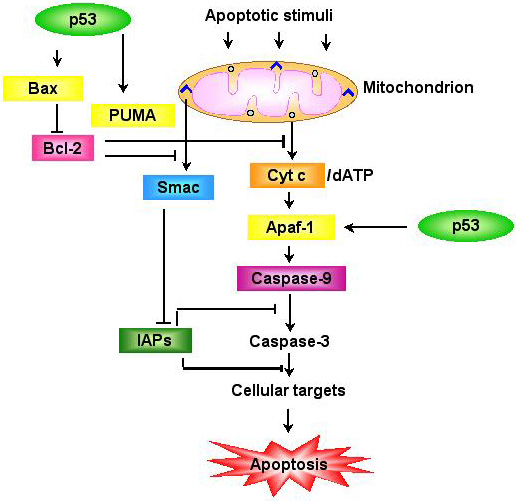PPS:增强抑癌基因功能或可帮助对抗癌症
| 导读 |
近日,来自俄勒冈州立大学的科学家通过研究发现了一种遗传因子Grasp(Grp1-associated scaffold protein,Grp1相关支架蛋白),其可以帮助促进P53抑癌基因的功能并抑制癌症发生。研究者说,如果找到方法来维持或者增强这种遗传因子的作用,便可以为癌症治疗提供了一条重要的新途径。
相关研究论文发表在《光化学和光生物... |

近日,来自俄勒冈州立大学的科学家通过研究发现了一种遗传因子Grasp(Grp1-associated scaffold protein,Grp1相关支架蛋白),其可以帮助促进P53抑癌基因的功能并抑制癌症发生。研究者说,如果找到方法来维持或者增强这种遗传因子的作用,便可以为癌症治疗提供了一条重要的新途径。
相关研究论文发表在《光化学和光生物学科学》(Photochemical and Photobiological Sciences)杂志上,作者是来自俄勒冈州立大学和俄勒冈健康与科学大学的研究团队。
P53基因涉及到损伤DNA的修复,如果细胞损伤太严重,P53基因会引发细胞凋亡,以防癌变。P53基因的失活与很多我们所知的癌症有关,特别是皮肤癌,食道癌,结肠癌,胰腺癌,肺癌,子宫癌,以及头与颈癌症。
本文研究的第一作者,马克-雷德教授说,DNA突变在我们人体内很容易发生,比如暴露在日光下几分钟就有可能引发基因突变。P53基因和其他的一些抑癌基因就会被激活从而修复DNA损伤,如果损伤太严重不能被修复,P53会引发细胞凋亡。如果这些抑癌基因正常运作,就可以预防癌症形成。但是P53基因有时会失活从而引发癌症。现在一些癌症治疗的途径就是基于刺激或激活P53蛋白来正常工作。
这项最新研究中,研究者发现,Grasp基因可以明显影响P53基因的正常功能。当Grasp没有充分表达时,进入细胞核完成修复或损伤细胞功能的p53蛋白质就会在其发挥功能之前从细胞核释放出来。
“Grasp,P19胚胎肿瘤细胞中维甲酸诱导基因的产物,主要表达在小鼠的脑部、心脏和肺部等部位。我们发现如果进行强烈的紫外诱导作用,也会在小鼠的皮肤细胞中发现Grasp转化子。”研究者写道,“Grasp-小鼠实验中发现剧烈地紫外暴露后,细胞增殖缓慢,细胞凋零循环也变得迟钝。免疫组织化学分析揭示,经过紫外诱变处理的Grasp-小鼠,P53蛋白在细胞核内的存在时间明显减少。通过以上实验现象,研究者们推断Grasp的生理作用是在紫外照射后通过减少P53引发的细胞凋亡反应来控制皮肤内的稳态。”
“这样看来Grasp的主要功能是在损伤的皮肤细胞的细胞核周围形成一个类似光环,起一个塞子的作用,使P53在细胞核内直至发挥其功能为止。”雷德博士强调,“如果可以找到一种药物增强Grasp的功能,也许会增强P53抑癌基因的作用,同时给我们提供了一条新路径来维持肿瘤抑制因子使其发挥正常作用。”(转化医学网360zhyx.com)
原文链接:
Genetic function of tumor suppressor gene discovered; could offer new avenue to cancer therapies
Scientists at Oregon State University say they have discovered a genetic function that helps the p53 tumor suppressor gene carry out its function and prevent cancer. Finding ways to maintain or increase the effectiveness of the gene in question—Grp1-associated scaffold protein, or Grasp—could offer an important new avenue for human cancer therapies, according to the researchers.
The study (“Grp1-associated scaffold protein regulates skin homeostasis after ultraviolet irradiation”) was published in Photochemical and Photobiological Sciences by researchers from OSU and Oregon Health & Science University.
The p53 gene is involved in repair of DNA damage and, if the damage is too great, causing a mutated cell to die before it can cause further problems, up to and including cancer. Dysfunction of p53 genetic pathways have been linked to more than half of all known cancers, particularly skin, esophageal, colon, pancreatic, lung, ovarian, and head and neck cancers.
“DNA mutations occur constantly in our bodies just by ordinary stresses, something as simple as exposure to sunlight for a few seconds,” explained Mark Leid, Ph.D., professor of pharmacology and associate dean for research in the OSU College of Pharmacy, and one of the lead authors on this study. “Just as constantly, the p53 gene and other tumor suppressors are activated to repair that damage. And in cases where the damage is too severe to be repaired, p53 will cause apoptosis of the mutated cell. Almost all of the time, when they are working right, these processes prevent the formation of cancers.”
But the activity and function of p53 can sometimes decline or fail, Dr. Leid said, and allow development of cancer.
Promising approaches to cancer therapy are now based on activating or stimulating the p53 protein to do its job.

来源:bioon
 腾讯登录
腾讯登录
还没有人评论,赶快抢个沙发